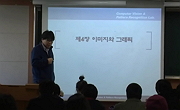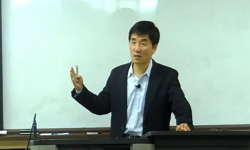본 연구의 목적은 발달성협응장애 중학생의 정보처리속도와 관련하여 인지적 부하량에 따라 나타나는 반응속도가 비장애 중학생과 비교하였을 때 어떠한 차별적 특징을 나타내는지 알아보...
http://chineseinput.net/에서 pinyin(병음)방식으로 중국어를 변환할 수 있습니다.
변환된 중국어를 복사하여 사용하시면 됩니다.
- 中文 을 입력하시려면 zhongwen을 입력하시고 space를누르시면됩니다.
- 北京 을 입력하시려면 beijing을 입력하시고 space를 누르시면 됩니다.

발달성협응장애 중학생과 비장애 중학생의 인지적 부하량에 따른 정보처리속도 비교 연구 = The Comparative Study on the Information Processing Speed by the Cognitive Load of the Middle School Students with and without Developmental Coordination Disorder
한글로보기https://www.riss.kr/link?id=A106303903
- 저자
- 발행기관
- 학술지명
- 권호사항
-
발행연도
2019
-
작성언어
-
- 주제어
-
KDC
692.379
-
등재정보
KCI등재
-
자료형태
학술저널
- 발행기관 URL
-
수록면
61-70(10쪽)
-
KCI 피인용횟수
3
- 제공처
-
0
상세조회 -
0
다운로드
부가정보
국문 초록 (Abstract)
본 연구의 목적은 발달성협응장애 중학생의 정보처리속도와 관련하여 인지적 부하량에 따라 나타나는 반응속도가 비장애 중학생과 비교하였을 때 어떠한 차별적 특징을 나타내는지 알아보고자 하였다. 대상자 선정을 위해 연령, 키, 몸무게, DCDQ-K, BOTMP-2 결과를 고려하여 발달성협응장애(DCD) 중학생 21명, 비장애(TD) 중학생 18명을 연구대상자로 선정하였으며 3가지 과제유형(단순, 선택, 변별)의 반응시간을 측정하였다. 측정된 데이터는 SPSS 23.0 프로그램을 사용하여 이원 반복측정 분산분석, 독립 t검정을 실시하였다. 연구결과는 다음과 같다. 첫째, 단순반응과제에서 시각-단순반응시간(t=5.391, p<.001)과 청각-단순반응시간(t=2.386, p<.05)에서 유의한 차이가 나타났다. 둘째, 선택반응과제에서 발달성협응장애 중학생 집단이 모든 과제에서 비장애 중학생 집단에 비해 반응시간이 더 긴 것(F(1,37)=58.9, p<.001)으로 나타났으며, 자극선택 과제에 따라 반응시간의 차이(F(2,36)=61.8, p<.001)가 있는 것으로 나타났다. 모든 과제에서 자극 선택의 수가 증가할수록 반응시간의 증가폭이 비장애 중학생 집단에 비해 더 큰 것으로 나타났다. 셋째, 변별반응 과제에서 발달성협응장애 중학생 집단이 모든 과제에서 비장애 중학생 집단에 비해 반응시간이 더 긴 것(F(1,37)=35.4, p<.001)으로 나타났으며, 자극변별 과제에 따라 반응시간에 차이(F(2,36)=18.3, p<.001)가 있는 것으로 나타났다. 자극변별 과제 간 차이 검정에서는 시각변별 2개 반응시간이 시각-단순반응시간(p<.001), 시각변별 3개 반응시간(p<.05)과 통계적으로 유의미한 차이로 더 오래 걸리는 것으로 나타났고, 시각-단순반응시간과 시각변별 3개 반응시간은 유의한 차이(p=.65)가 나타나지 않았다. 따라서, 본 연구결과는 발달성협응장애 중학생이 전형적인 발달과정에 있는 비장애 중학생들보다 정보처리에 어려움을 겪고 있음을 시사하며, 특히 인지적 부하량이 늘어날수록 과제에 따른 반응패턴 양상의 차이보다는 반응시간이 늘어나는 양상에 향후 연구에 계속적인 초점을 맞추어야 할 필요가 있다고 사료된다.
다국어 초록 (Multilingual Abstract)
The purpose of this study was to distinguish characteristics of the reaction time in respect to the information processing speed of a middle school student with developmental coordination disorder(DCD) compared to a typical developing(TD) middle schoo...
The purpose of this study was to distinguish characteristics of the reaction time in respect to the information processing speed of a middle school student with developmental coordination disorder(DCD) compared to a typical developing(TD) middle school student. 21 DCD middle school students and 18 TD middle school students were selected as subjects of the study considering their result of DCDQ-K and BOTMP-2 test. They were introduced to three types of reaction time assignment (simple, selective and discriminative). The results was then analyzed with two-way repeated measured analysis and independent t-test by the SPSS 23.0 program. First, there was a significant difference in visual-simple reaction time in simple response tasks (t=5.391, p<.001) and auditory-simple reaction time (t=2.386, p<.05). Second, DCD students showed longer reaction time than TD students in all selective response task (F(1,37)=58.9, p<.001). Moreover, there were difference in reaction time (F(2,36) = 61.8, p<.001) depending on the stimuli selection task given. The reaction time increased greatly in DCD than that of TD students as the number of stimulation options increased in each tasks. Third, in the specific response task, the group of DCD students had a longer response time than the group of TD students in all tasks (F(1,37)=35.4, p<.001); difference in response time (F(2,36)=18.3, p<.001) were found depending on the stimuli-discrimination tasks. Two response times for each visual-discrimination task were visual-simple reaction times (p<.001), 3 response times per visual variation (p<.05), and statistically significant differences, while 3 response times per visual variation (p=).65) did not appear. Therefore, the findings suggest that DCD students are having difficulty processing information during the typical development process than TD students, and it is suggested for the future research to focus on patterns of response times than the differences in response patterns due to tasks as cognitive load increases.
참고문헌 (Reference)
1 남수미, "발달성협응장애 아동의 반응시간에 관한 예비연구" 한국초등체육학회 22 (22): 47-58, 2017
2 최승오, "발달성 협응력 장애인의 운동감각에 대한 심리물리학적 분석" 한국특수체육학회 11 (11): 157-168, 2003
3 Hulme, C., "Visual, kinaesthetic and cross‐modal judgements of length by normal and clumsy children" 24 (24): 461-471, 1982
4 Sanders, A. F., "Towards a model of stress and human performance" 53 (53): 61-97, 1983
5 Wall, A. E., "The syndrome of physical awkwardness;Problems in movement control" 74 : 283-316, 1990
6 Larkin, D., "The movement approach : A window to understanding the clumsy child" 84 : 413-439, 1992
7 Tsai, C. L., "The effectiveness of exercise intervention on inhibitory control in children with developmental coordination disorder : Using a visuospatial attention paradigm as a model" 30 (30): 1268-1280, 2009
8 Wilson, B. N., "The developmental coordination disorder questionnaire 2007(DCDQ’07)"
9 Wickens, C. D., "Temporal limits of human information processing : A developmental study" 81 (81): 739-, 1974
10 Massaro, D. W., "Relationships between perception and action" 133-166, 1990
1 남수미, "발달성협응장애 아동의 반응시간에 관한 예비연구" 한국초등체육학회 22 (22): 47-58, 2017
2 최승오, "발달성 협응력 장애인의 운동감각에 대한 심리물리학적 분석" 한국특수체육학회 11 (11): 157-168, 2003
3 Hulme, C., "Visual, kinaesthetic and cross‐modal judgements of length by normal and clumsy children" 24 (24): 461-471, 1982
4 Sanders, A. F., "Towards a model of stress and human performance" 53 (53): 61-97, 1983
5 Wall, A. E., "The syndrome of physical awkwardness;Problems in movement control" 74 : 283-316, 1990
6 Larkin, D., "The movement approach : A window to understanding the clumsy child" 84 : 413-439, 1992
7 Tsai, C. L., "The effectiveness of exercise intervention on inhibitory control in children with developmental coordination disorder : Using a visuospatial attention paradigm as a model" 30 (30): 1268-1280, 2009
8 Wilson, B. N., "The developmental coordination disorder questionnaire 2007(DCDQ’07)"
9 Wickens, C. D., "Temporal limits of human information processing : A developmental study" 81 (81): 739-, 1974
10 Massaro, D. W., "Relationships between perception and action" 133-166, 1990
11 Marteniuk, R. G., "Motor short-term memory measures as a function of methodology" 9 (9): 247-250, 1977
12 Sage, G. H., "Motor learning and control: A neuropsychological approach" Brown 1984
13 Lord, R., "Kinaesthetic sensitivity of normal and clumsy children" 29 (29): 720-725, 1987
14 Marteniuk, R. G., "Information processing in motor skills" Holt, Rinehart and Winston 1976
15 Smyth, T. R., "Information processing deficits in clumsy children" 38 (38): 13-22, 1986
16 Fitts, P. M., "Human performance"
17 Blank, R., "European academy for childhood disability (EacD): recommendations on the definition, diagnosis and intervention of developmental coordination disorder (long version)" 54 : 54-93, 2012
18 American Psychiatric Association, "Diagnostic and statistical manual of mental disorders"
19 이규진, "Developmental Coordination Disorder Questionnaire 2007 (DCDQ’07)의 번안 및 신뢰도 연구" 한국특수체육학회 24 (24): 99-110, 2016
20 Henderson, S. E., "Concomitants of clumsiness in young schoolchildren" 24 (24): 448-460, 1982
21 Henderson, S. E., "Clumsiness or developmental coordination disorder : A neglected handicap" 2 : 158-162, 1992
22 Geuze, R. H., "Clinical and research diagnostic criteria for developmental coordination" 20 (20): 7-47, 2001
23 Bruininks, R. H., "BOT2 : Bruininks-oseretsky test of motor proficiency" AGS Publishing 2005
동일학술지(권/호) 다른 논문
-
평창 동계올림픽 및 평창 동계패럴림픽에 대한 기간별 소셜 미디어의 관심도 차이 분석
- 한국특수체육학회
- 황영진 ( Young-jin Hwang )
- 2019
- KCI등재
-
운동 중재가 뇌성마비 아동의 보행 능력에 미치는 효과에 대한 메타분석
- 한국특수체육학회
- 이규진 ( Kyu-jin Lee )
- 2019
- KCI등재
-
거울 시각 피드백을 이용한 매트 필라테스 운동이 만성 뇌졸중 환자의 균형에 미치는 영향
- 한국특수체육학회
- 임희성 ( Hee-sung Lim )
- 2019
- KCI등재
-
장애인 생활체육지도자의 스트레스 대처방식과 직무 매너리즘의 관계
- 한국특수체육학회
- 홍상민 ( Sang-min Hong )
- 2019
- KCI등재
분석정보
인용정보 인용지수 설명보기
학술지 이력
| 연월일 | 이력구분 | 이력상세 | 등재구분 |
|---|---|---|---|
| 2026 | 평가예정 | 재인증평가 신청대상 (재인증) | |
| 2022-03-25 | 학회명변경 | 영문명 : Korean Society Of Adapted Physical Activity And Exercise -> Korean Society Of Adapted Physical Activity |  |
| 2022-02-04 | 학술지명변경 | 외국어명 : Journal of adapted physical activity and exercise -> Korean Journal of Adapted Physical Activity |  |
| 2020-01-01 | 평가 | 등재학술지 유지 (재인증) |  |
| 2017-01-01 | 평가 | 등재학술지 유지 (계속평가) |  |
| 2013-01-01 | 평가 | 등재 1차 FAIL (등재유지) |  |
| 2010-01-01 | 평가 | 등재학술지 유지 (등재유지) |  |
| 2008-01-01 | 평가 | 등재학술지 유지 (등재유지) |  |
| 2006-01-01 | 평가 | 등재 1차 FAIL (등재유지) |  |
| 2001-01-01 | 평가 | 등재학술지 선정 (등재후보2차) |  |
| 1998-07-01 | 평가 | 등재후보학술지 선정 (신규평가) |  |
학술지 인용정보
| 기준연도 | WOS-KCI 통합IF(2년) | KCIF(2년) | KCIF(3년) |
|---|---|---|---|
| 2016 | 1.2 | 1.2 | 1.41 |
| KCIF(4년) | KCIF(5년) | 중심성지수(3년) | 즉시성지수 |
| 1.28 | 1.31 | 1.18 | 0.4 |





 KCI
KCI KISS
KISS




